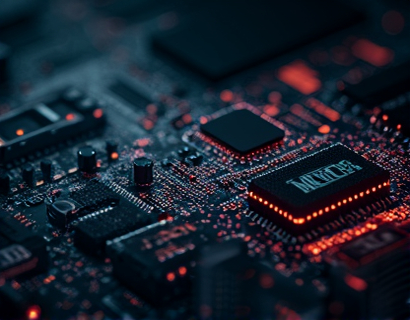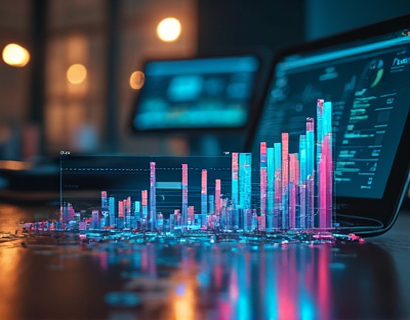Next-Gen Smart Contract AMMs: Revolutionizing DeFi Trading with Advanced Automation and Liquidity Management
The decentralized finance (DeFi) ecosystem has witnessed unprecedented growth and innovation, with smart contract-based Automated Market Makers (AMMs) emerging as a cornerstone of this transformation. These AMMs leverage advanced automation and liquidity management to redefine the trading experience, offering crypto traders and DeFi enthusiasts unparalleled efficiency and seamless market interactions. This article delves into the cutting-edge technology behind next-generation smart contract AMMs, exploring how they optimize liquidity management and automate trading strategies to ensure optimal performance in the dynamic crypto landscape.
Understanding Smart Contract AMMs
Traditional AMMs rely on algorithms to determine asset prices and manage liquidity pools, eliminating the need for order books and human intervention. Smart contract AMMs take this a step further by deploying on blockchain networks, ensuring transparency, security, and immutability. These contracts execute predefined rules automatically, facilitating trades without intermediaries. The use of smart contracts in AMMs not only reduces costs but also enhances trust among participants, as all transactions are verifiable and tamper-proof.
The core mechanism of a smart contract AMM involves liquidity pools, where users deposit assets to create a pool. These pools are used for trading, and participants earn liquidity provision rewards. The price of assets in the pool is determined by the ratio of the two assets in the pool, typically using a constant product formula such as x * y = k, where x and y are the amounts of the two assets, and k is a constant. This formula ensures that the price adjusts dynamically based on market demand and supply.
Advanced Automation in AMMs
Next-generation smart contract AMMs incorporate advanced automation features that go beyond basic liquidity provision and trading. These features include algorithmic trading, risk management, and automated rebalancing, which collectively enhance the trading experience and optimize portfolio performance.
Algorithmic trading allows users to execute complex trading strategies automatically, based on predefined criteria such as price movements, volatility, and market trends. By integrating machine learning models, these AMMs can adapt to changing market conditions, identifying profitable opportunities and minimizing losses. This level of automation not only saves time but also reduces emotional decision-making, leading to more rational and consistent trading outcomes.
Risk management is another critical aspect of advanced AMMs. These platforms employ sophisticated risk assessment tools to monitor and mitigate potential losses. Features such as stop-loss orders, position sizing algorithms, and real-time risk metrics help users manage their exposure effectively. By automating these processes, users can focus on higher-level strategy development while the AMM handles the intricacies of risk control.
Automated rebalancing ensures that liquidity pools maintain optimal asset ratios, which is essential for maintaining fair prices and preventing liquidity drains. When asset prices fluctuate, the rebalancing mechanism adjusts the pool's composition to maintain the desired ratio. This process is crucial for maintaining the integrity of the AMM and ensuring that traders have access to liquidity at fair prices.
Liquidity Management Innovations
Effective liquidity management is the backbone of any successful AMM. Next-gen smart contract AMMs introduce innovative solutions to enhance liquidity provision and utilization, addressing some of the key challenges faced by traditional AMMs.
One such innovation is the implementation of dynamic fee structures. Unlike static fee models, dynamic fees adjust based on market conditions, providing incentives for liquidity providers during periods of high volatility or low liquidity. This approach encourages more participants to contribute liquidity when it's most needed, thereby improving market depth and reducing slippage for traders.
Another advancement is the introduction of cross-chain liquidity. By leveraging interoperability protocols, these AMMs enable liquidity to flow across different blockchain networks. This not only increases the overall liquidity available in the ecosystem but also provides traders with access to a broader range of assets and markets. Cross-chain liquidity pools can tap into underserved markets, enhancing the efficiency and reach of DeFi protocols.
Tokenized liquidity is another game-changing feature. By representing liquidity as tokens, these AMMs allow for fractional ownership and easier transferability of liquidity positions. This tokenization simplifies the process of providing and withdrawing liquidity, making it more accessible to a wider range of participants. Users can buy, sell, and trade liquidity tokens on decentralized exchanges, adding another layer of liquidity to the ecosystem.
Enhancing User Experience through Advanced Features
Beyond the core functionalities, next-gen smart contract AMMs focus on enhancing the overall user experience through a suite of advanced features. These features aim to make trading more intuitive, efficient, and user-friendly, catering to both novice and experienced traders.
One such feature is real-time market data integration. By connecting to reliable oracles, these AMMs provide up-to-date market information, ensuring that traders have access to accurate and timely data. This transparency is crucial for making informed trading decisions and maintaining trust in the platform.
User-friendly interfaces and dashboards are also essential. These platforms offer intuitive dashboards that display key metrics such as portfolio performance, liquidity provision status, and trading history. Visualizations and charts help users quickly grasp market trends and assess their positions, facilitating better decision-making.
Personalized trading recommendations are another valuable feature. By analyzing user behavior and market data, these AMMs can offer tailored suggestions for trading strategies, asset allocations, and risk management techniques. These recommendations are based on advanced algorithms and machine learning models, providing users with actionable insights to optimize their trading performance.
Security and Trust in Smart Contract AMMs
Security remains a paramount concern in the DeFi space, and next-gen smart contract AMMs prioritize robust security measures to protect user assets and ensure trust. Smart contracts are audited by leading security firms to identify and mitigate vulnerabilities. Additionally, formal verification techniques are employed to mathematically prove the correctness of the contract logic, reducing the risk of bugs and exploits.
Governance tokens play a crucial role in the security and governance of these AMMs. Token holders can participate in decision-making processes, proposing and voting on upgrades, bug fixes, and other critical changes. This decentralized governance model ensures that the platform evolves in line with the community's needs and maintains high standards of security and transparency.
Insurance mechanisms are also integrated to provide an additional layer of protection. These mechanisms pool funds from liquidity providers and insurance pools to cover potential losses due to smart contract vulnerabilities or external factors. While not a guarantee against all risks, insurance adds a sense of security and stability to the platform.
Future Prospects and Challenges
The future of smart contract AMMs looks promising, with ongoing developments poised to address current challenges and unlock new possibilities. One of the key areas of focus is scalability. As the DeFi ecosystem grows, the need for high-throughput, low-latency AMMs becomes increasingly important. Layer 2 solutions and optimized smart contract designs are being explored to enhance performance and reduce transaction costs.
Interoperability is another critical aspect. By seamlessly integrating with various blockchain networks and protocols, next-gen AMMs can create a more interconnected and efficient DeFi ecosystem. This interoperability will facilitate cross-chain trading, asset portability, and the creation of more complex financial products.
Regulatory compliance is a challenge that the DeFi space must navigate carefully. As governments and regulatory bodies start to pay more attention to DeFi, smart contract AMMs will need to adapt to ensure compliance with financial regulations. This may involve implementing know-your-customer (KYC) and anti-money laundering (AML) protocols, while maintaining the decentralized nature of the platform.
Lastly, user education remains a vital component of the growth of smart contract AMMs. As these platforms become more sophisticated, it's essential to provide comprehensive resources and support to help users understand the underlying technology and best practices for trading and liquidity provision. By fostering a well-informed community, the DeFi ecosystem can continue to thrive and expand.
In conclusion, next-gen smart contract AMMs are revolutionizing DeFi trading by introducing advanced automation, sophisticated liquidity management, and enhanced user features. These innovations not only optimize market interactions but also empower users to make more informed and strategic trading decisions. As the technology continues to evolve, the potential for further advancements and broader adoption in the crypto landscape is immense.











































